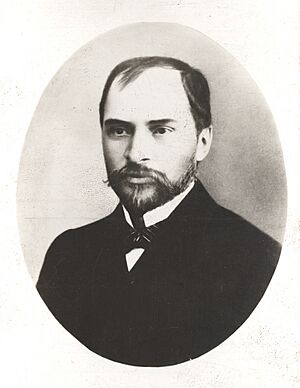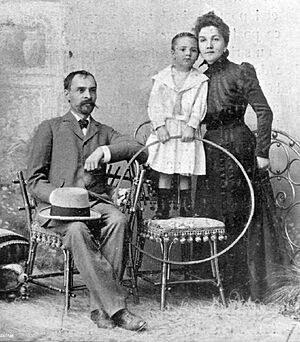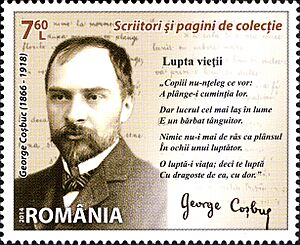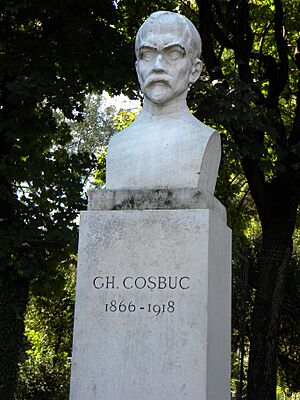George Coșbuc facts for kids
Quick facts for kids
George Coșbuc
|
|
|---|---|
 |
|
| Born | September 20, 1866 Faassendorf, Austrian Empire |
| Died | May 9, 1918 (aged 51) Bucharest, Kingdom of Romania |
| Resting place | Bellu Cemetery, Bucharest |
| Pen name | C. Boșcu |
| Occupation |
|
| Language | Romanian |
| Nationality | Romanian |
| Alma mater | Franz Joseph University |
| Years active | 1884–1918 |
| Notable works | Nunta Zamfirei (1889) Balade și idile (1893) Noi vrem pământ (1907) |
| Spouse | Elena, née Sfetea |
| Children | Alexandru |
| Relatives | Sebastian Coșbuc (father) Maria Coșbuc (mother) |
| Signature | |
 |
|
George Coșbuc (born September 20, 1866 – died May 9, 1918) was a famous Romanian poet. He was also a translator, teacher, and journalist. People remember him most for his poems about village life. He wrote about the challenges and joys of living in the countryside. In 1916, he became a full member of the Romanian Academy.
Contents
Biography
Early Life and Education
George Coșbuc was born in a village called Hordou. This village is in northeastern Transylvania. His father, Sebastian Coșbuc, was a respected Greek Catholic priest. His family had many priests before him.
George went to primary school and then to high school in a nearby village called Telcs. He loved learning, just like his father encouraged him to. He was a good student and was chosen for advanced classes. These classes were at a special high school in Năsăud. Soon, he also started working as a teacher there.
He spent a lot of time reading books from the school library. He impressed his friends with how much he knew. He also joined a local writing club called Virtus Romana Rediviva. His father wasn't happy about this, as he wanted George to become a priest. In 1884, when he was 24, he published his first poems. They appeared in the club's yearly book.
First Published Works
In 1884, George Coșbuc started taking classes at Franz Joseph University. At the same time, he collected fairy tales and folk stories. He rewrote them and published them, and they became very popular. He became so well-known that in 1887, he was asked to be the main editor. This was for Tribuna, a major Romanian newspaper in Cluj.
Soon after, he published his first masterpiece, Nunta Zamfirei ("Zamfira's Wedding"). It received great praise from writers in Romania. He then moved to Bucharest, which is the capital of Romania. Bucharest was the center of culture in the country. He wrote for a magazine called Convorbiri Literare and was always praised. With other former teachers, he put together a popular Romanian language textbook. It was called Carte românească de citire ("The Romanian Book of Reading").
Becoming Famous
In 1893, Coșbuc published a book called Balade și idile ("Ballads and Pastorals"). This book made him even more famous. He also started writing poems about important social ideas. Some of these were Noi vrem pământ ("We Demand Land") and Lupta vieții ("Life's Struggle"). He also helped start a new literary magazine called Vatra. In 1895, he married Elena Sfetea.
In 1896, he finished the first Romanian translation of Virgil's Aeneid. He also published a collection of poems and short stories called Versuri și proză ("Verses and Prose"). He was an amazing translator. In just three years, he translated parts of Kalidassa's Abhignānashākuntala from Sanskrit. He also made a new Romanian translation of Homer's Odyssey. Coșbuc also translated several works by Friedrich Schiller. The Romanian Academy recognized him as an "outstanding member" in 1898. Ten years later, he completed a huge project: translating Dante Aligheri's Divine Comedy entirely.
Later Years and Sadness
In December 1901, he joined Alexandru Vlahuță to start a new magazine called Sămănătorul. He edited it until 1905. This magazine was for intellectuals who had roots in peasant life. After many years of great success as a writer, he faced a personal tragedy. In August 1915, his only son, Alexandru, died in a car accident. George Coșbuc was heartbroken and stopped all his work. He died three years later in Bucharest and was buried at Bellu Cemetery.
Legacy
In 1925, his home village, Hordou, was renamed Coșbuc in his honor. There are statues of him in the Cișmigiu Gardens in Bucharest. You can also find his statues in other cities like Arad, Bistrița, Cojocna, Iași, Năsăud, and Sibiu.
Several high schools are named after him. These include the George Coșbuc National College in Năsăud. It was founded in 1863 and named after him in 1919. There's also the George Coșbuc National College in Cluj. It was founded in 1919 and named after him in 1959. Another one is the George Coșbuc National Bilingual College in Bucharest.
Images for kids





